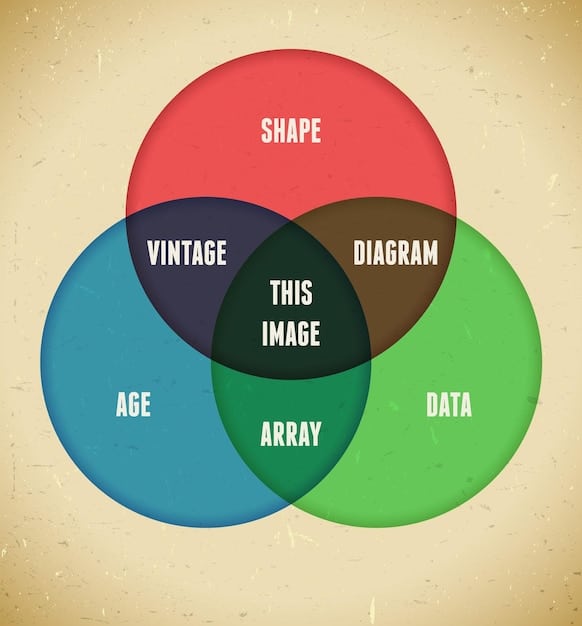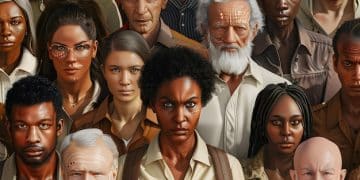Streaming’s Impact: Redefining American Cultural Consumption

Streaming services are profoundly reshaping American cultural consumption habits, influencing everything from how people access entertainment and information to what types of content gain popularity and how cultural trends emerge.
The rise of streaming services has revolutionized how Americans consume culture. How Streaming Services are Redefining American Cultural Consumption Habits is a complex phenomenon impacting everything from television and film to music and news.
The Digital Transformation of Entertainment
The traditional landscape of entertainment has been upended by the proliferation of streaming platforms. Understanding this shift requires examining how digital access has reshaped viewing habits and preferences.
Accessibility and Convenience
Streaming services have made content more accessible than ever before. With a single subscription, users can access a vast library of movies, TV shows, and documentaries on demand.
Changing Viewing Habits
Binge-watching has become a common practice, with many viewers preferring to consume entire seasons of a show in a single sitting. This has altered the way stories are told, as creators now design shows with the expectation of continuous viewing.
- On-demand access allows viewers to watch content at their convenience, breaking from traditional broadcast schedules.
- The sheer volume of content available has increased competition for viewers’ attention.
- Personalized recommendations and curated playlists enhance the user experience, making it easier to discover new content.
The ease and flexibility of streaming have fundamentally altered the way Americans engage with entertainment. This shift has implications for content creators, advertisers, and the broader cultural landscape. For example, families may gather around the television to watch a movie on Netflix instead of going to a movie theater. These small changes aggregate to make a big change.
The Fragmentation of Audiences
Streaming services have led to a more fragmented audience. Instead of everyone watching the same few shows, viewers are spread across a multitude of platforms and niche content offerings.
Niche Content and Diverse Voices
Streaming platforms have provided opportunities for niche content to find an audience. Shows that might not have been viable on traditional television can thrive on streaming services, catering to specific interests and demographics.
The Decline of Shared Cultural Experiences
As audiences become more fragmented, shared cultural experiences become less common. The water cooler moments once dominated by network television are now scattered across various streaming platforms.

- Streaming services offer a long tail of content, catering to a wide range of tastes and preferences.
- The rise of niche content has empowered diverse voices and perspectives.
- Algorithmic recommendations can create echo chambers, limiting exposure to different viewpoints.
This fragmentation has both positive and negative consequences. On the one hand, it allows for greater diversity and inclusivity. On the other hand, it can lead to a decline in shared cultural touchstones.
The Globalization of Content
Streaming services have played a key role in the globalization of content. Shows and movies from around the world are now readily available to American audiences, exposing viewers to different cultures and perspectives.
The Rise of International Content
Streaming platforms have invested heavily in international content, producing shows and movies in various languages and regions. These productions often find a global audience, breaking down cultural barriers and promoting cross-cultural understanding.
The Influence of Korean Dramas and Spanish-Language Shows
Korean dramas and Spanish-language shows have gained immense popularity on streaming services. These shows have introduced American audiences to new storytelling styles and cultural norms.
- Dubbing and subtitling have made international content more accessible to American viewers.
- The success of international shows has encouraged streaming platforms to invest in more diverse programming.
- Global content provides a window into different cultures and perspectives, fostering empathy and understanding.
This globalization of content is transforming American cultural consumption habits, broadening tastes and challenging traditional notions of what constitutes mainstream entertainment. People around the world are connecting in new ways and this can be a big component of peace.
The Impact on Film and Television Industries
The rise of streaming services has had a profound impact on the film and television industries. Traditional studios and networks are now competing with streaming giants for viewers and talent.

The Shift to Direct-to-Streaming Releases
Many movies that would have traditionally been released in theaters are now premiering directly on streaming services. This shift has accelerated the decline of the theatrical experience and altered the economics of the film industry.
The Rise of Streaming Originals
Streaming platforms are investing heavily in original content, producing high-quality shows and movies that rival those of traditional studios. This has led to a golden age of television, with more options and higher production values than ever before.
- Traditional studios are adapting to the streaming era by launching their own streaming services.
- The competition between traditional and streaming platforms is driving innovation and experimentation.
- The economics of content creation are changing, with new revenue models and distribution strategies emerging.
The film and television industries are undergoing a period of rapid transformation, as they adapt to the challenges and opportunities presented by streaming services. As these industries change, viewers are benefactors.
The Changing Landscape of News and Information
Streaming services are also changing the way Americans consume news and information. Many platforms now offer news channels and documentaries, providing an alternative to traditional broadcast news.
The Rise of Streaming News Channels
Streaming news channels offer a 24/7 stream of news and analysis, often with a particular political slant. These channels cater to viewers who are looking for news that aligns with their own beliefs and perspectives.
The Popularity of Documentaries
Streaming services have become a popular destination for documentaries, covering a wide range of topics and issues. Documentaries offer in-depth analysis and storytelling that can be difficult to find elsewhere.
- Streaming news channels can reinforce partisan divides and contribute to political polarization.
- Documentaries can educate and inform viewers about important social and political issues.
- The algorithms that recommend news and documentaries can create filter bubbles, limiting exposure to different viewpoints.
The changing landscape of news and information presents both opportunities and challenges. Streaming services can provide access to a wealth of information, but they can also contribute to misinformation and political polarization.
The Future of Cultural Consumption
As streaming services continue to evolve, they will undoubtedly play an even greater role in shaping American cultural consumption habits. The future is likely to bring even more personalized experiences, interactive content, and new forms of entertainment.
The Rise of Interactive Content
Some streaming services are experimenting with interactive content, allowing viewers to make choices that affect the outcome of a story. This type of content has the potential to revolutionize storytelling and create more immersive experiences.
The Integration of Virtual Reality and Augmented Reality
Virtual reality (VR) and augmented reality (AR) technologies are poised to transform the way we consume content. Streaming services could offer VR experiences that transport viewers to different worlds, or AR applications that overlay digital content onto the real world.
- Personalized recommendations will become even more sophisticated, tailoring content to individual tastes and preferences.
- New forms of entertainment, such as esports and live streaming, will continue to gain popularity.
- The boundaries between entertainment, education, and social interaction will continue to blur.
The future of cultural consumption is likely to be more personalized, interactive, and immersive than ever before. Streaming services will be at the forefront of this transformation, shaping the way Americans experience and engage with culture.
| Key Point | Brief Description |
|---|---|
| 📺 Digital Transformation | Streaming provides on-demand access, altering viewing habits. |
| 🌍 Content Globalization | International shows gain popularity, breaking cultural barriers. |
| 🎬 Industry Impact | Film and TV industries adapt to streaming giants. |
| 📰 News Consumption | Streaming alters news consumption habits with news channels. |
Frequently Asked Questions
▼
Streaming services have enabled on-demand and binge-watching habits, changing how television and film are consumed. This shift allows viewers to watch what they want, when they want it.
▼
Streaming has led to direct-to-streaming releases and increased investment in original content. Traditional studios now compete with the economics of creating movies.
▼
Streaming platforms are offering news channels and documentaries, providing alternatives to traditional broadcast news. This shift in consumption is both diverse and niche at the same time.
▼
Yes, streaming services offer access to international content, breaking cultural barriers. This exposes viewers to different storylines and new perspectives.
▼
The future likely involves personalized experiences and interactive content driven by streaming technology. Immersive content will transform how the media industry grows.
Conclusion
In conclusion, streaming services have profoundly reshaped American cultural consumption habits, impacting entertainment, news, and the broader cultural landscape. The ease of access and the abundance of available content is changing the entertainment industry for the better.





